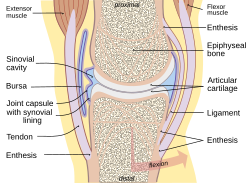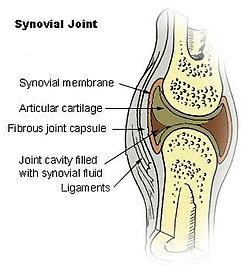
Back غشاء زلالي Arabic Membrana sinovial Catalan Membrana sinovial Spanish غشاء سینوویال (کالبدشناسی) Persian Membrane synoviale French Ձուսպաթաղանթ Armenian Membran sinovial ID Membrana sinoviale Italian 滑膜 Japanese Membrana synovialis Latin
| Synovial membrane | |
|---|---|
 Typical joint | |
 Synovial joint | |
| Details | |
| Identifiers | |
| Latin | membrana synovialis capsulae articularis |
| MeSH | D013583 |
| TA98 | A03.0.00.028 |
| TA2 | 1538 |
| FMA | 66762 |
| Anatomical terminology | |
The synovial membrane (also known as the synovial stratum, synovium or stratum synoviale) is a specialized connective tissue that lines the inner surface of capsules of synovial joints, tendon sheaths, and synovial bursas.[1][2] It makes direct contact with the fibrous membrane on the outside surface and with the synovial fluid lubricant on the inside surface. In contact with the synovial fluid at the tissue surface are many rounded macrophage-like synovial cells (type A) and also type B cells, which are also known as fibroblast-like synoviocytes (FLS). Type A cells maintain the synovial fluid by removing wear-and-tear debris. As for the FLS, they produce hyaluronan, as well as other extracellular components in the synovial fluid.[3]
- ^ Young, Barbara; Lowe, James S.; Stevens, Alan; Heath, John W.; Deakin, Philip J. (2006). Wheater's Functional Histology: A Text and Colour Atlas (5th ed.). Churchill Livingstone. ISBN 9780443068508.
- ^ Nelson, Fred R T; Blauvelt, Carolyn Taliaferro (2015). A Manual of Orthopedic Terminology (8th ed.). Elsevier. p. 70. ISBN 978-0-323-22158-0.
- ^ Junqueira's Basic Histology: Text and Atlas (13th ed.). McGraw-Hill Education / Medical. 2013-02-13. ISBN 9780071780339.